Introduction
Law enforcement agencies worldwide are under pressure to modernize operations while maintaining public trust. Rising crime complexity, data overload, and constrained resources demand smarter approaches. Artificial Intelligence (AI) is now playing a critical role in reshaping law enforcement—from crime prevention and investigations to real-time threat response.
This guide explores how AI is transforming policing with real-world applications, measurable benefits, and critical challenges that agencies must address to use AI responsibly and effectively.
What is AI and Why Does It Matter in Law Enforcement?
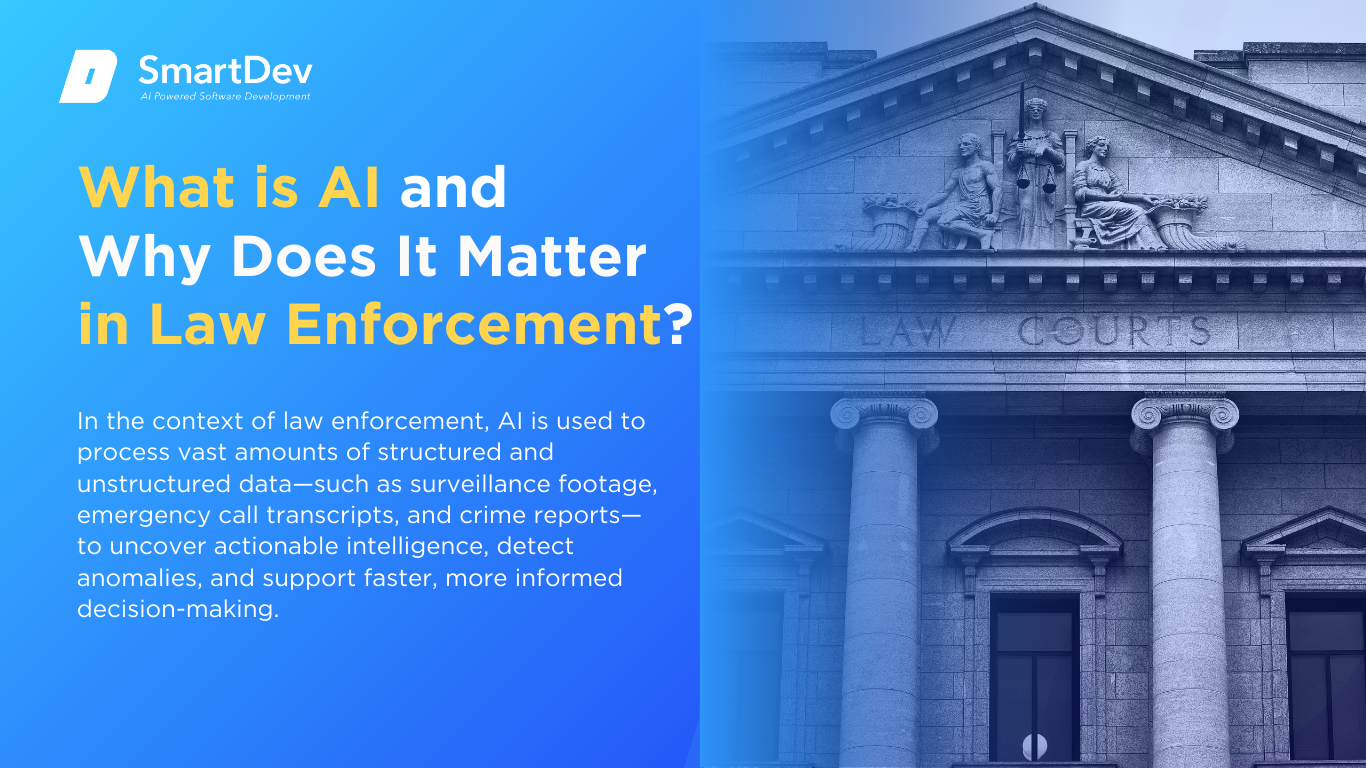 Definition of AI and Its Core Technologies
Definition of AI and Its Core Technologies
Artificial Intelligence (AI) refers to computer systems that can perform tasks traditionally requiring human intelligence, including learning from data, identifying patterns, and making decisions. Core technologies include machine learning (ML), computer vision, and natural language processing (NLP) source.
In the context of law enforcement, AI is used to process vast amounts of structured and unstructured data—such as surveillance footage, emergency call transcripts, and crime reports—to uncover actionable intelligence, detect anomalies, and support faster, more informed decision-making.
Want to explore how AI can transform your sector? Discover real-world strategies for deploying smart technologies in airline systems. Visit How to Integrate AI into Your Business in 2025 to get started today and unlock the full potential of AI for your business!
The Growing Role of AI in Transforming Law Enforcement
AI is revolutionizing surveillance and monitoring. Computer vision allows law enforcement to automatically detect suspicious activities, weapons, or individuals of interest across hundreds of camera feeds—something human officers can’t feasibly monitor in real time.
Predictive policing systems analyze historical crime data to forecast potential hotspots. This helps departments allocate patrol units proactively and deter crime before it happens. While controversial, when implemented with oversight, it can enhance efficiency without violating civil liberties.
AI also enhances investigations. NLP engines can analyze and transcribe thousands of documents or case files to surface relevant patterns, link suspects, or identify previously overlooked connections. This dramatically reduces investigation time while increasing case accuracy.
Key Statistics or Trends in AI Adoption
Adoption is growing rapidly. According to the U.S. Department of Justice, over 90% of large law enforcement agencies in the United States use some form of AI or data analytics, particularly in surveillance and crime analysis source.
Real-time crime centers powered by AI are expanding. Cities like New York, Chicago, and London now use AI-enhanced systems to combine video surveillance, gunshot detection, and license plate recognition (LPR) into integrated response platforms.
The global market for AI in public safety is projected to grow from $9.3 billion in 2023 to $29.1 billion by 2030, at a CAGR of 17.8% source, driven by smart city initiatives and rising demands for data-driven policing.
Business Benefits of AI in Law Enforcement
AI technologies are delivering tangible operational improvements. Here are five key benefits that law enforcement agencies are already realizing.
 1. Faster and Smarter Criminal Investigations
1. Faster and Smarter Criminal Investigations
AI speeds up digital forensics and case review. Tools like Cellebrite and Palantir help analyze large volumes of digital data—including messages, emails, and call logs—to identify relationships between suspects and evidence.
NLP-based systems can scan thousands of incident reports or case files for relevant keywords or patterns, saving investigators hours of manual reading. This results in faster resolutions and more accurate case building.
2. Enhanced Surveillance and Situational Awareness
Traditional surveillance is limited by human attention spans. AI-powered video analytics platforms can detect loitering, fights, illegal gatherings, or abandoned objects in real time, triggering alerts for immediate response.
Facial recognition, though controversial, is used in controlled scenarios such as matching suspects against criminal databases at airports or during amber alerts—helping locate wanted individuals or missing persons more efficiently.
3. Predictive Policing and Resource Allocation
AI models can predict crime trends by analyzing historical data combined with weather, events, or socio-economic indicators. This helps commanders deploy patrols more effectively and anticipate high-risk situations.
Agencies like LAPD and London’s MET have tested predictive tools for burglary and gun violence, allowing for better planning, visibility, and community safety outcomes—though with strict oversight to ensure fairness.
4. Improved Emergency Response and Dispatch
NLP tools are now integrated into emergency dispatch systems to transcribe and analyze 911 calls in real time. AI can flag keywords that indicate domestic violence, mental health crises, or active shooter scenarios—prompting quicker escalation or specialized response units.
This improves response accuracy, saves lives, and helps dispatchers triage calls faster in high-pressure environments.
5. Fraud, Cybercrime, and Threat Detection
Cybercrime and financial fraud investigations now rely on AI to detect abnormal patterns in banking, telecommunications, and online activities. AI also helps track illegal online marketplaces and monitor extremist content across social platforms.
Machine learning models scan dark web activity or social chatter to flag threats before they materialize, giving law enforcement a head start in threat mitigation and cyber intelligence.
Challenges Facing AI Adoption in Law Enforcement
Despite the benefits, integrating AI into law enforcement workflows presents real risks and challenges that demand attention. Here are five key concerns.
 1. Ethical and Civil Liberties Concerns
1. Ethical and Civil Liberties Concerns
AI in law enforcement raises serious concerns about surveillance, racial bias, and individual freedoms. Facial recognition systems, for example, have been criticized for disproportionately misidentifying people of color.
Without proper governance, AI may reinforce discriminatory practices. Agencies must implement transparency measures, conduct regular audits, and ensure ethical AI usage aligned with constitutional rights
For those navigating these complex waters, a business-oriented guide to responsible AI and ethics offers practical insights on deploying AI responsibly and transparently, especially when public trust is at stake.
2. Data Quality and Bias in Algorithms
AI systems are only as good as the data they’re trained on. Inaccurate, incomplete, or biased datasets can lead to flawed predictions—impacting everything from crime forecasts to suspect identification.
To mitigate this, agencies must use diverse, representative datasets and continuously monitor model performance. Data science teams should work closely with legal and community stakeholders to ensure fairness.
Siloed systems and scattered data can cripple decision-making and slow growth. Discover how AI is helping organizations unify, clean, and unlock value from their data faster and smarter. Explore the full article to see how AI transforms data chaos into clarity.
3. Lack of Regulatory Frameworks
Most jurisdictions lack clear, updated legal frameworks around AI in policing. This creates uncertainty around data use, accountability, and citizen rights—potentially exposing agencies to legal and reputational risks.
Governments and civil society must co-develop guidelines that balance innovation with oversight. Initiatives like the EU’s AI Act and U.S. Executive Order on AI are steps in this direction, but more domain-specific regulations are needed.
4. Skills and Technology Gaps
Many law enforcement agencies lack the technical skills and infrastructure to deploy AI responsibly. There’s a gap between the complexity of AI tools and the day-to-day capabilities of officers and analysts.
Agencies must invest in training programs, interdisciplinary teams (including data scientists and legal experts), and scalable technology platforms to close this gap and drive adoption.
5. Public Trust and Community Engagement
Deploying AI without transparency can erode community trust—especially in marginalized areas. Public backlash can stall or reverse AI programs if citizens feel they are being unfairly surveilled or targeted.
Agencies should adopt open communication strategies, publish explainability reports, and involve communities in oversight boards or technology audits. Trust must be earned, not assumed.
Specific Applications of AI in Law Enforcement
Use case 1. Predictive Policing and Crime Forecasting
Law enforcement agencies face rising pressure to prevent crime with limited resources. Predictive policing uses AI to analyze historical crime data, identify patterns, and forecast potential criminal activity locations. This allows departments to allocate patrol units more effectively and deter incidents before they occur.
Machine learning algorithms process data on crime types, timestamps, and geographic locations. These models detect trends, hotspots, and recurring behaviors, often visualized through GIS tools. Integration happens via command center dashboards and field operation planning tools.
The strategic benefit is enhanced deterrence, optimized patrol scheduling, and reduced response times. Concerns include bias from historical data, ethical policing practices, and the need for transparency in how decisions are made.
Real-World Example:
Los Angeles Police Department (LAPD) piloted predictive policing software to identify potential crime zones. Using PredPol’s algorithm, they deployed units based on risk scores derived from historical incidents. This contributed to a reported 12% drop in property crime in test areas.
Use case 2. Intelligent Document Processing (IDP) for Case and Evidence Management
Law enforcement deals with extensive documentation, from incident reports to court submissions. Intelligent Document Processing (IDP) streamlines the extraction and categorization of information from scanned forms, witness statements, and evidence files. This reduces administrative burdens and accelerates case workflows.
IDP employs OCR, NLP, and ML to digitize and organize structured and unstructured documents. It also integrates with case management systems and digital evidence repositories. These tools improve accessibility, data integrity, and chain-of-custody tracking.
Benefits include time savings, improved documentation accuracy, and easier collaboration across departments. Security, privacy, and auditability are vital due to the sensitive nature of law enforcement data.
Real-World Example:
The UK’s West Midlands Police deployed AI-powered document processing to manage incident reports. Using automation tools from Capita, they digitized thousands of documents and reduced manual input time by 40%. This freed up officers for fieldwork and improved case resolution speed.
Use case 3. AI-Powered Surveillance and Video Analytics
Surveillance cameras generate massive video data that is difficult to monitor manually. AI-powered video analytics enables real-time object recognition, facial matching, and behavior detection to enhance situational awareness. It supports investigations and live monitoring in critical areas.
Computer vision and deep learning models process video streams to detect predefined activities (e.g., loitering, intrusion, weapon detection). These systems are integrated with command centers and mobile devices for instant alerting. Facial recognition adds identity verification in restricted zones.
The value includes faster threat identification, improved public safety, and evidence validation. Legal frameworks and ethical safeguards are essential to avoid privacy violations and ensure appropriate use.
Real-World Example:
New York Police Department (NYPD) uses AI video analytics to monitor subway stations and public events. Powered by BriefCam and IBM, the system identifies unusual crowd movement and tracks persons of interest. It enabled faster response to disturbances and supported criminal investigations.
Use case 4. AI Chatbots for Non-Emergency Public Interaction
Police departments manage thousands of non-emergency inquiries daily. AI chatbots streamline citizen communication by automating responses about filing reports, court schedules, or public safety tips. This improves community engagement while reducing call center strain.
Chatbots use NLP trained on department FAQs, regulations, and service protocols. They operate via web portals, mobile apps, or public kiosks. Escalation protocols ensure seamless handoffs to human officers when needed.
Strategically, chatbots increase responsiveness, improve public trust, and ensure round-the-clock access to information. Privacy and clarity in automated interactions are key for user confidence.
Real-World Example:
The Singapore Police Force launched an AI-powered chatbot to answer public queries on crime prevention and law procedures. Built on Microsoft Azure, it handles over 100,000 inquiries annually. The chatbot improved citizen satisfaction and reduced workload on call handlers.
Use case 5. AI in Digital Forensics and Evidence Analysis
Digital evidence from mobile devices, emails, and online activity plays a critical role in modern investigations. AI assists forensic teams in extracting, filtering, and correlating digital data faster. This accelerates investigations and improves prosecutorial outcomes.
AI tools use pattern recognition, keyword extraction, and timeline reconstruction across digital artifacts. These models are embedded in forensic platforms used for analyzing hard drives, cloud data, and communication logs. They assist in establishing case narratives and identifying suspects.
Key advantages include time efficiency, reduced manual review, and increased case success rates. Chain-of-custody and result verifiability are essential for admissibility in court.
Real-World Example:
Europol uses AI in its digital forensic labs to automate data triage and analysis from seized devices. Tools like Griffeye and Magnet AXIOM enabled faster review of terabytes of data. AI helped accelerate investigations involving cybercrime, child exploitation, and terrorism.
Use case 6. AI for Internal Affairs and Officer Monitoring
Maintaining integrity and accountability within police forces is crucial. AI helps analyze officer behavior, complaint trends, and performance data to flag risks proactively. It supports internal affairs and promotes transparency.
AI systems analyze body camera footage, incident reports, and personnel records. Predictive analytics highlight outlier behavior, use-of-force patterns, or early warning signs. These insights are shared with compliance teams or department leadership.
Strategically, this improves officer conduct oversight, supports training programs, and rebuilds public trust. Agencies must ensure ethical data use and protect officer rights in monitoring.
Real-World Example:
Chicago Police Department uses AI to identify officers at risk of misconduct through its Strategic Subject List initiative. Predictive analytics flagged individuals for early intervention. This contributed to better oversight and reduced serious incidents over time.
Need Expert Help Turning Ideas Into Scalable Products?
Partner with SmartDev to accelerate your software development journey — from MVPs to enterprise systems.
Book a free consultation with our tech experts today.
Let’s Build TogetherExamples of AI in Law Enforcement
AI adoption in law enforcement is no longer experimental—it’s delivering measurable impact. The following case studies show how AI supports safety, efficiency, and accountability.
Real-World Case Studies
 London Metropolitan Police: AI for Image Recognition in Investigations
London Metropolitan Police: AI for Image Recognition in Investigations
The Metropolitan Police Service in London implemented AI facial recognition tools to support criminal investigations. These systems scanned live CCTV feeds and compared images against a database of known individuals. During major public events, AI-assisted monitoring increased the accuracy and speed of suspect identification.
Facial recognition trials improved suspect match rates and reduced the time needed to review surveillance footage. Officers could more rapidly respond to public safety threats and verify identities in real time. This led to a 19% increase in arrests during the pilot phases and strengthened the force’s investigative capabilities.
Indian Police: Predictive Policing for Crime Hotspot Mapping
In cities like Delhi, Hyderabad, and Bengaluru, police departments are leveraging AI to identify high-crime zones. By analyzing past crime data, demographics, and time-of-day patterns, predictive models produce maps highlighting potential hotspots. These insights guide patrol allocation and resource planning.
AI-generated hotspot predictions are delivered to officers via mobile apps for real-time use in the field. This targeted policing method helped reduce street-level crimes, such as theft and assault, by over 25% in trial zones. Officers also reported greater confidence in their situational awareness and decision-making.
U.S. FBI: AI in Criminal Network Detection
The Federal Bureau of Investigation (FBI) uses AI to map and disrupt criminal organizations. Machine learning algorithms analyze communication records, social media activity, financial transactions, and surveillance data to uncover connections between individuals and events. These insights help build profiles of threat networks.
Through partnerships with companies like Palantir, the FBI developed tools that visualize network structures and detect anomalies in communication flows. These systems played a crucial role in dismantling cybercrime syndicates and thwarting coordinated attacks. The use of AI has also accelerated the case-building process for prosecutors.
These examples reflect the value of working with technology partners who understand both the technical and policy implications. If you’re considering a similar digital transformation, don’t hesitate to connect with AI implementation experts to explore what’s possible in your context.
Innovative AI Solutions
AI is pushing the boundaries of traditional law enforcement models with new tools for efficiency and trust. Innovations are emerging across mobility, intelligence gathering, and community relations.
Generative AI is being piloted to draft incident summaries, victim statements, and field notes. This reduces administrative load and ensures consistency in documentation. Officers can focus more on community engagement and safety.
Drone surveillance powered by AI enables real-time monitoring of large public gatherings and disaster zones. Visual analytics identify threats and guide emergency response. This enhances situational command and reduces human risk.
AI-based emotion analysis and behavioral prediction are being explored for conflict de-escalation. Tools analyze voice tone and facial expressions in live interactions. These assist officers in adjusting engagement strategies on the spot
AI‑Driven Innovations Transforming Law Enforcement
Law enforcement agencies across the globe are leaning into artificial intelligence as a pivotal tool in modern policing. The U.S. Department of Justice’s final report in response to Executive Order 14110 (December 2024) identifies four main AI applications—identification and surveillance, forensic analytics, predictive policing, and risk assessment—demonstrating an accelerated shift toward AI-enabled public safety systems. You, whether as police leadership or a chief technology strategist, are seeing AI solutions move from theory to mission-critical operations, delivering faster investigations, smarter analytics, and cost-efficient resource allocation.
This landscape includes agencies utilizing automated license plate readers, real-time video analytics, and drone deployment. For instance, the NYPD’s Domain Awareness System merges CCTV, license-plate reader data, and crime reports to power analytics tools like Patternizr, enabling rapid crime pattern matching and case resolution. Similarly, Flock Safety’s AI-enabled license-plate recognition systems contribute to over 10% of solved investigations in the U.S., offering both deterrent presence and lead generation.
Emerging Technologies in AI for Law Enforcement
AI-based facial recognition has been adopted by numerous police departments, driving arrest efficiency and deterrence. Research by Johnson & Johnson found that cities adopting facial recognition technology saw an average 14% drop in homicide rates from the date of implementation through 2020. Clearview AI is widely used—Miami Police report 450 searches annually, each treated as leads rather than final evidence, ensuring traditional investigative rigor follows AI matches.
AI-driven video analytics and anomaly detection systems convert existing camera networks into real-time monitoring tools. Smart Video Solutions deployed in campus environments processed multiple camera feeds at ~16.5 FPS and raised alerts to stakeholders with ~27-second latency, demonstrating how computer vision can scale surveillance and anomaly detection rapidly and responsively.
Drone technology is also emerging as a rapid-response AI tool. In the U.S., police departments now deploy drones as first responders—often arriving at emergency scenes faster than patrol cars, reducing risks, and extending capabilities such as medical supply delivery and threat assessment.
AI’s Role in Sustainability Efforts in Law Enforcement
AI enhances resource optimization in law enforcement by reducing manual investigative workloads and improving deployment efficiency. Platforms like Patternizr in DAS help triage crime alerts and direct investigative focus to high‑value cases, cutting case backlog and increasing clearance rates. Predictive crime‑zone redesign, as implemented in Atlanta, resulted in a 5.8% faster response time and 43% more balanced officer workload across zones—a clear gain in sustainability of operations.
Automated reporting tools like Axon’s Draft One have cut police report writing time by 64–67% in pilot deployments—freeing up officers for community engagement, patrol, and other mission-critical tasks.
How to Implement AI in Law Enforcement
 Step 1: Assessing Readiness for AI Adoption
Step 1: Assessing Readiness for AI Adoption
Your agency’s first step is to evaluate organizational, legal, and cultural readiness. Begin by identifying operational pain points where AI could deliver measurable impact—such as in incident reporting, suspect identification, or patrol resource planning. At the same time, examine the digital maturity of your department. Consider whether your existing infrastructure can support AI workflows and if there are gaps in data access, storage, or interoperability.
Readiness also involves understanding the regulatory landscape. Agencies must ensure compliance with both federal and local laws concerning privacy, surveillance, and criminal evidence standards. For example, cities with restrictions on facial recognition technology may need to revise or limit certain use cases. Conducting a legal gap analysis—ideally in collaboration with counsel—will help your team anticipate compliance risks and policy conflicts.
Perhaps most importantly, readiness is rooted in public trust. Before implementing AI, engage with community stakeholders. Hosting open forums, partnering with civic organizations, and inviting feedback from oversight boards helps foster legitimacy and transparency. When the public understands how AI will be used—and, just as critically, how it won’t be used—you’re far more likely to gain community support for deployment.
Step 2: Building a Strong Data Foundation
Artificial intelligence systems are only as effective as the data they are trained on. In law enforcement, data is often fragmented across systems—ranging from incident logs and arrest records to video surveillance and forensic databases. Before deploying AI, agencies must focus on data consolidation and hygiene. This means establishing common standards for naming conventions, metadata tagging, timestamp accuracy, and event classification. Integrating legacy systems with modern platforms is essential to ensure consistency and accessibility.
It’s also crucial to address data governance. Sensitive information—particularly that involving personally identifiable information—must be protected through encryption, access controls, and internal accountability. You should also prioritize transparency in how your data is collected, stored, shared, and used. Establishing audit trails and documenting the source of each data point will improve trust and reduce the risk of internal misuse or public backlash.
Bias mitigation starts at the data level. Historical datasets in law enforcement often reflect over-policing in marginalized communities. Feeding these patterns into AI systems without intervention can amplify discriminatory outcomes. To avoid this, agencies must engage in bias auditing, use representative and balanced training data, and implement external review processes that examine how AI decisions align with fairness principles.
Step 3: Choosing the Right Tools and Vendors
Selecting AI vendors is a strategic decision that impacts legal liability, public accountability, and operational outcomes. Agencies should work with providers that offer transparency around how their models function, especially in critical applications like facial recognition or predictive risk assessment. It’s essential that vendors provide documentation about model accuracy, bias testing, and validation benchmarks. Choosing solutions that support explainability, meaning officers and supervisors can understand how conclusions were reached, adds another layer of ethical safeguard.
Security and compliance are also key. Tools must offer strong protections around data lineage, access logs, and system auditing. Interoperability with existing law enforcement infrastructure—such as CAD, RMS, or body-worn camera platforms—is another important criterion. Vendors should also demonstrate how their tools meet or exceed current legal standards and can adapt to changes in policy or oversight.
Agencies must be careful to define liability and support responsibilities clearly in contracts. If an AI tool contributes to a wrongful arrest or misidentification, it must be clear who bears the responsibility and how remediation will be handled. Clarity around training, performance updates, system retraining, and long-term maintenance is just as critical as initial performance claims.
Step 4: Pilot Testing and Scaling Up
Pilot programs are essential for testing effectiveness, uncovering unexpected risks, and refining operational procedures before scaling AI deployment across your entire agency. These pilots should be tightly scoped—whether by geography, use case, or time frame—and should focus on low-risk areas such as administrative reporting or triaging non-violent incidents. This provides a safe environment to measure impact, gather feedback, and make improvements without compromising mission-critical functions.
When conducting a pilot, it’s essential to establish a baseline for comparison. For example, if you’re testing AI-generated incident reports, track the average time officers spent writing reports before implementation. During the pilot, monitor not only time savings, but also error rates, user satisfaction, and downstream impacts such as review time or legal accuracy. In parallel, collect qualitative feedback from users—officers, supervisors, and even community members—to evaluate perceptions of fairness, usability, and trust.
Once the pilot demonstrates value, the agency can begin a staged scale-up. This includes creating standardized documentation for processes, setting up internal governance structures to oversee deployment, and offering training and support to departments that are next in line for implementation. Scaling should never be rushed; instead, use a phased model that allows for iterative feedback and adaptation, so that mistakes in one precinct don’t cascade across the entire system.
Step 5: Training Teams for Successful Implementation
Training is not a one-time event—it’s an ongoing commitment. Law enforcement personnel must not only know how to use AI tools but also when and why to use them. Officers need to understand the capabilities and limits of the technology. For example, a facial recognition match should be treated as an investigative lead, not definitive evidence of guilt. Training should focus on how to interpret AI outputs, cross-reference with human judgment, and take ethical considerations into account when making real-world decisions.
To build confidence and competence, agencies should adopt a mix of hands-on simulations, case-based learning, and policy workshops. Scenario training—where officers are presented with real-world situations involving AI-generated alerts, reports, or identifications—can help develop the judgment needed to respond appropriately. Supervisors should be included in all training initiatives so they can reinforce policy expectations and act as first-line support for questions or issues.
Just as importantly, non-operational staff—such as legal teams, records officers, IT administrators, and communications specialists—must understand the implications of AI usage. This enables your agency to respond effectively to audits, legal challenges, or media inquiries. Creating a shared knowledge base across all departments ensures AI implementation is not just a technical rollout, but a cultural and institutional shift.
Whether you’re exploring your first pilot or scaling an enterprise-wide solution, our team is here to help. Get in touch with SmartDev and let’s turn your supply chain challenges into opportunities.
Measuring the ROI of AI in Law Enforcement
Key Metrics to Track Success
ROI in law enforcement isn’t solely financial. Track narrative improvements: reduced time-per-case, faster response times, higher clearance rates, fewer false positives, and enhanced staff capacity. FRT adoption correlated with a 14% drop in homicides in studied cities. Atlanta’s data‑driven zone redesign cut response-times by nearly 6% and ensured workload equity across precincts. Draft One pilots reduced report preparation time by over 60%, enabling officers to redirect time towards patrol and engagement. Measure both hard gains (time, cases closed, patrol hours) and soft gains (trust, transparency, satisfaction).
Case Studies Demonstrating ROI
In Atlanta, implementing a data-optimized patrol zone design drove a 5.8% improvement in high-priority 911 response time and a 43% better balance of workload across zones, showcasing clear operational uplift. San Francisco PD’s trial of Draft One AI-powered report drafting shaved nearly two‑thirds off paperwork time, enabling officers to reclaim dozens of hours per week for core policing tasks. A study across 268 cities using FRT showed sustained homicide reduction of about 14% after implementation, underlining impact on public safety.
Understanding ROI is possibly a challenge to many businesses and institutions as different in background, cost. So, if you need to dig deep about this problem, you can read AI Return on Investment (ROI): Unlocking the True Value of Artificial Intelligence for Your Business
Common Pitfalls and How to Avoid Them
Law enforcement agencies can overestimate reliability or ignore governance. Facial recognition misidentifications—especially of Black and brown individuals—underscore the need for human oversight. Several wrongful arrests have occurred due to overreliance on AI alone—highlighting that detection must be followed by investigative confirmation. Gunshot detection systems like ShotSpotter have generated high false-positive rates (up to 80%), prompting cities to cancel contracts due to limited crime reduction impact. To avoid these issues, build audit trails, set high accuracy thresholds, mandate human validation, and maintain transparency with the public.
Future Trends of AI in Law Enforcement
 Predictions for the Next Decade
Predictions for the Next Decade
AI tools will evolve into integrated crime center ecosystems. Expect expanded use of drones as first responders, AI bots triaging incidents and dispatching human units, and predictive systems alerting to potential hotspots preemptively. “Precrime” systems—such as those used in U.K. prisons—monitor behavior patterns for early intervention. In U.S. policing, similar systems like Compas-style risk scoring or “heat list” programs may escalate, though they bring intense scrutiny over fairness and presumption of innocence.
Computer vision tools will power citywide anomaly detection, crowd monitoring, and live threat recognition. Predictive analytics will assist in resource planning, incident prevention, and optimizing patrol routes. AI ecosystems will become autonomous orchestration engines for policing operations.
How Businesses (Agencies) Can Stay Ahead of the Curve
To lead, agencies must embed AI into broader strategic transformation—not just tactical toolkits. Invest in ethical frameworks, data governance, public transparency, and community engagement. Train leadership and officers in responsible use, auditability, and AI oversight. Build reusable AI modules—report drafting, anomaly detection, FRT scoring—that scale across departments. Benchmark against global peer benchmarks and tools like the Responsible AI Toolkit, and continuously review regulatory developments and community feedback. Agencies that foster human-AI collaboration and evolve policies alongside technology will generate sustainable public safety outcomes.
Conclusion
Summary of Key Takeaways on AI Use Cases in Law Enforcement
AI use cases in law enforcement span facial recognition, predictive policing, drone response, video analytics, and AI-assisted reporting. Cities using facial recognition saw an average 14% drop in homicides, while data-driven zone design cut response times significantly. AI report drafting reduced officers’ paperwork by over 60%, and drone penetration accelerates response. But success hinges on governance: high thresholds for thresholds, human oversight, bias mitigation, and transparent policy.
Moving Forward: A Path to Progress for Businesses Considering AI Adoption
You should act strategically: start with readiness assessments, align leadership expectations, build ethical frameworks, pilot in low-risk workflows with clear KPIs, invest in clean data systems, train staff thoroughly, and scale only from validated pilots. Measure both soft and hard metrics—response times, case clearances, equity, staff utilization, and community trust.
Establish public transparency, explainability, and review mechanisms to prevent misuse. AI in policing is not merely automation—it’s an opportunity to transform public safety responsibly. Adopt it wisely, ethically, and systematically—and you will lead the future of law enforcement.
References
- https://www.europol.europa.eu/publication-events/main-reports/ai-and-policing
- https://www.ncsl.org/civil-and-criminal-justice/artificial-intelligence-and-law-enforcement-the-federal-and-state-landscape
- https://www.ai-lawenforcement.org/
- https://www.policingproject.org/ai-explained-articles/2024/9/6/how-policing-agencies-use-ai
- https://www.ojp.gov/ncjrs/virtual-library/abstracts/artificial-intelligence-applications-law-enforcement-overview
- https://eucrim.eu/news/europol-report-benefits-and-challenges-of-ai-for-law-enforcement/
- https://www.policechiefmagazine.org/navigating-future-ai-chatgpt/


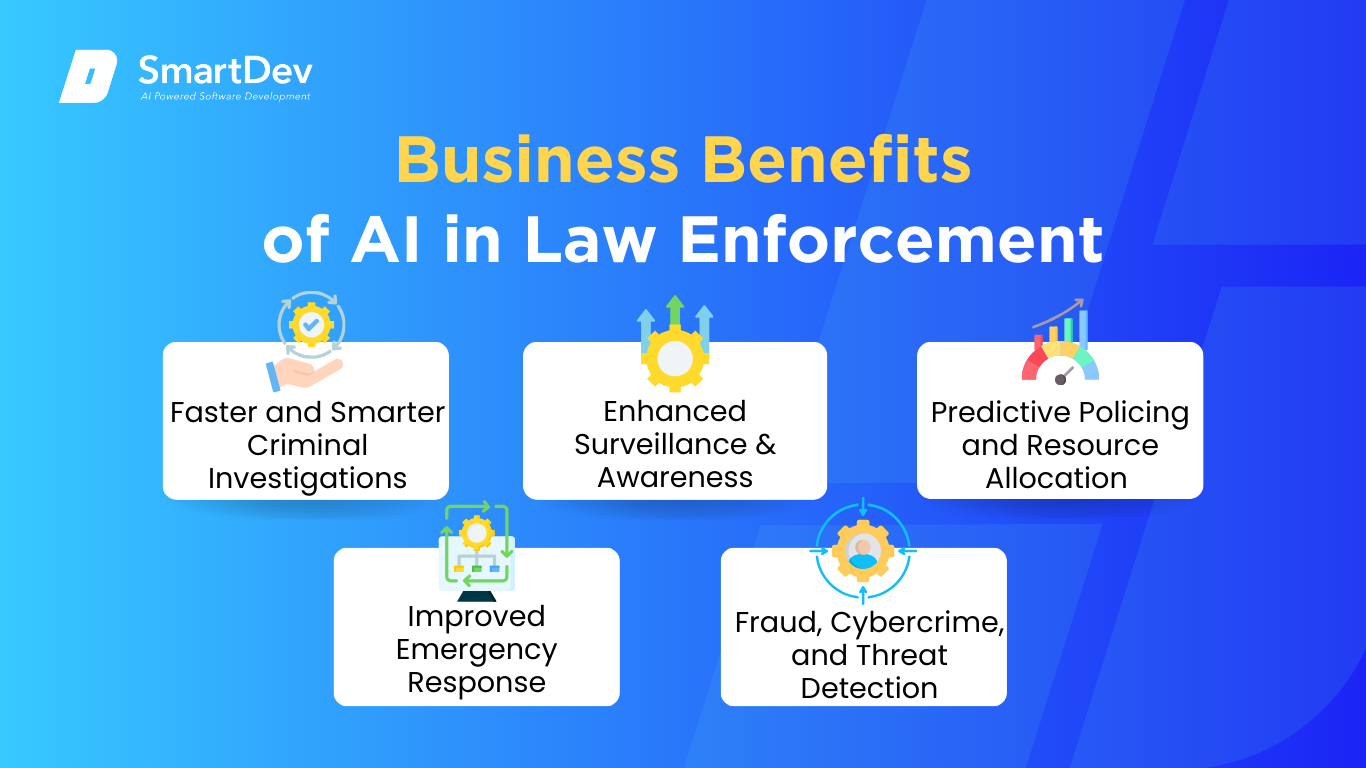 1. Faster and Smarter Criminal Investigations
1. Faster and Smarter Criminal Investigations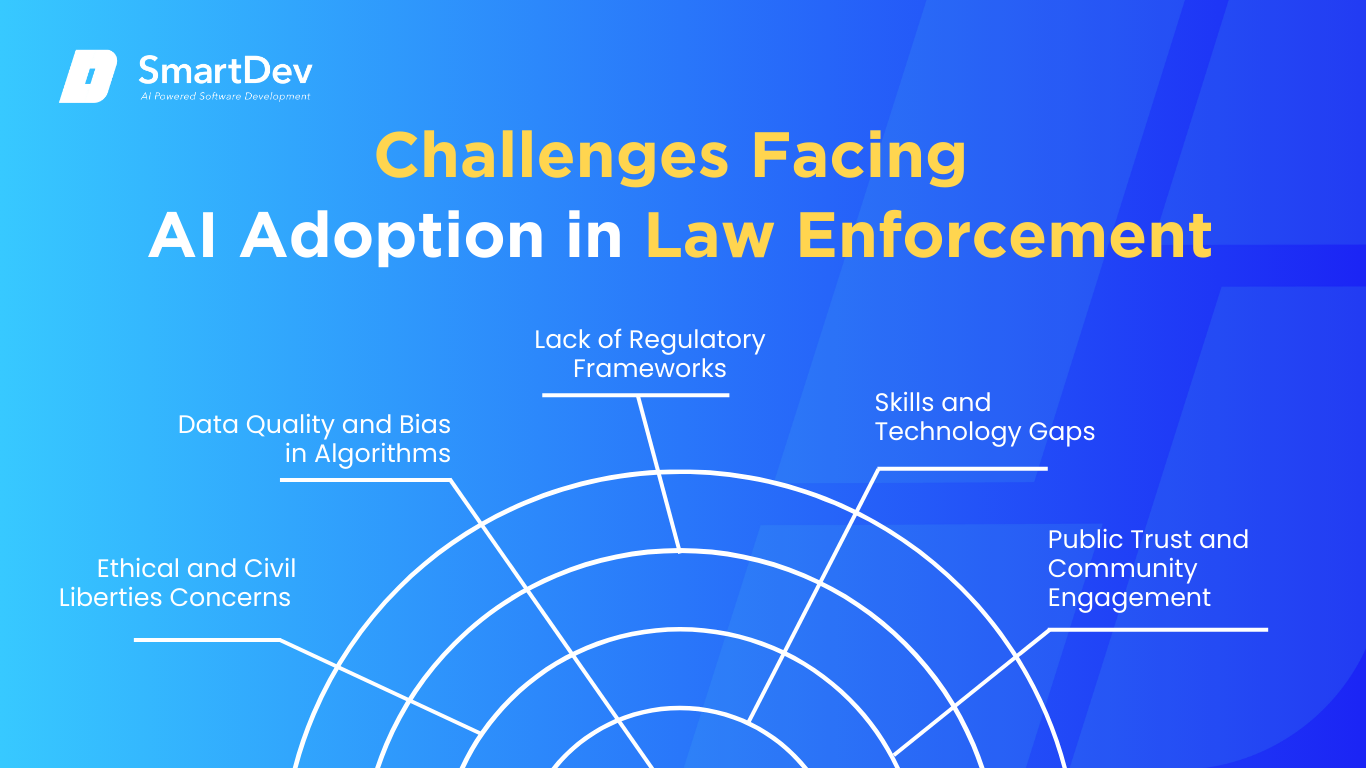 1. Ethical and Civil Liberties Concerns
1. Ethical and Civil Liberties Concerns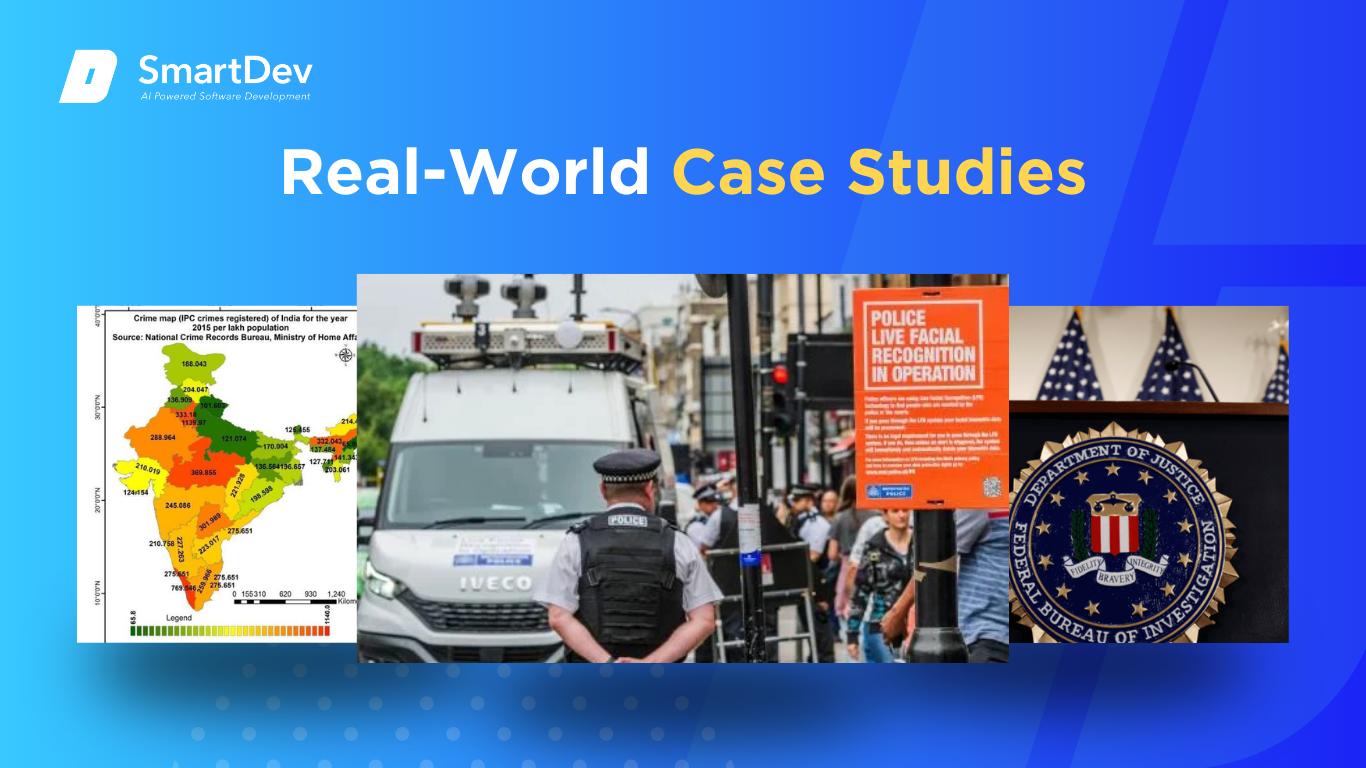 London Metropolitan Police: AI for Image Recognition in Investigations
London Metropolitan Police: AI for Image Recognition in Investigations 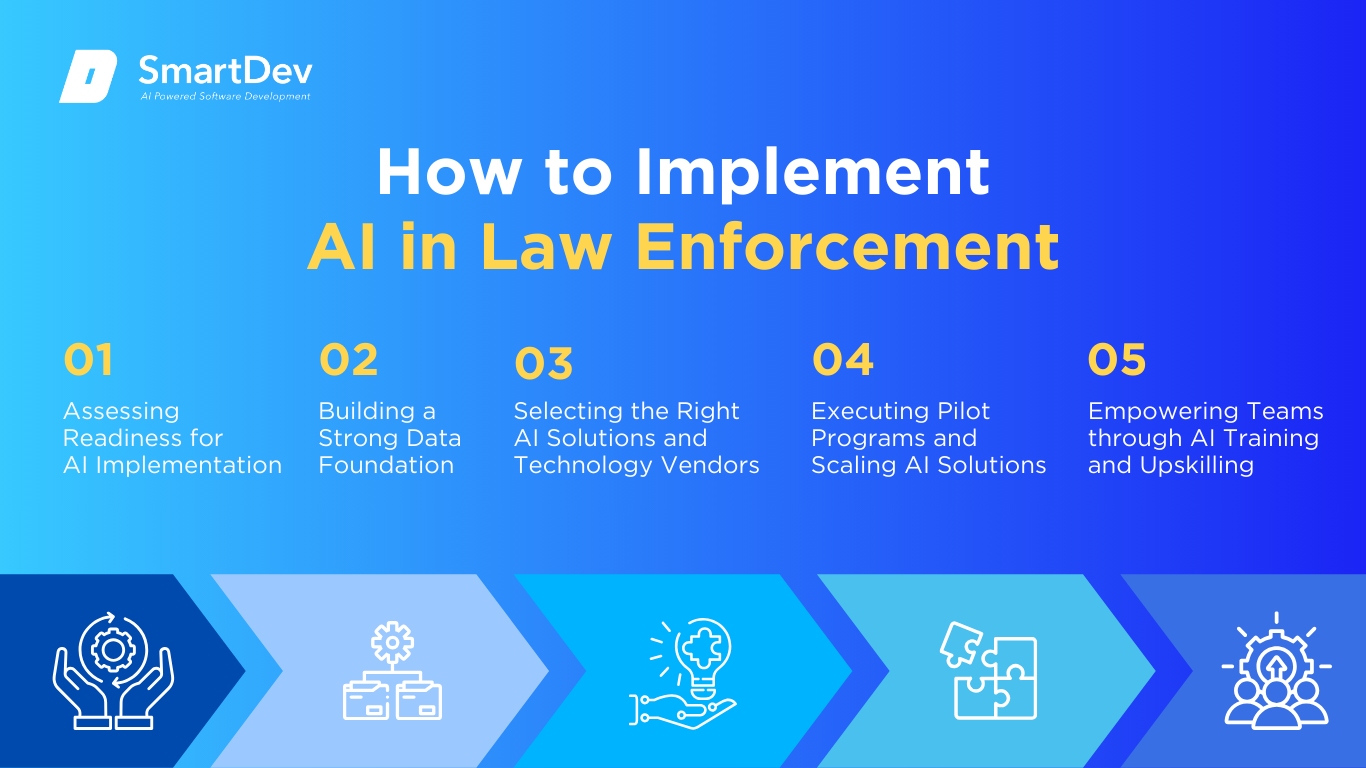 Step 1: Assessing Readiness for AI Adoption
Step 1: Assessing Readiness for AI Adoption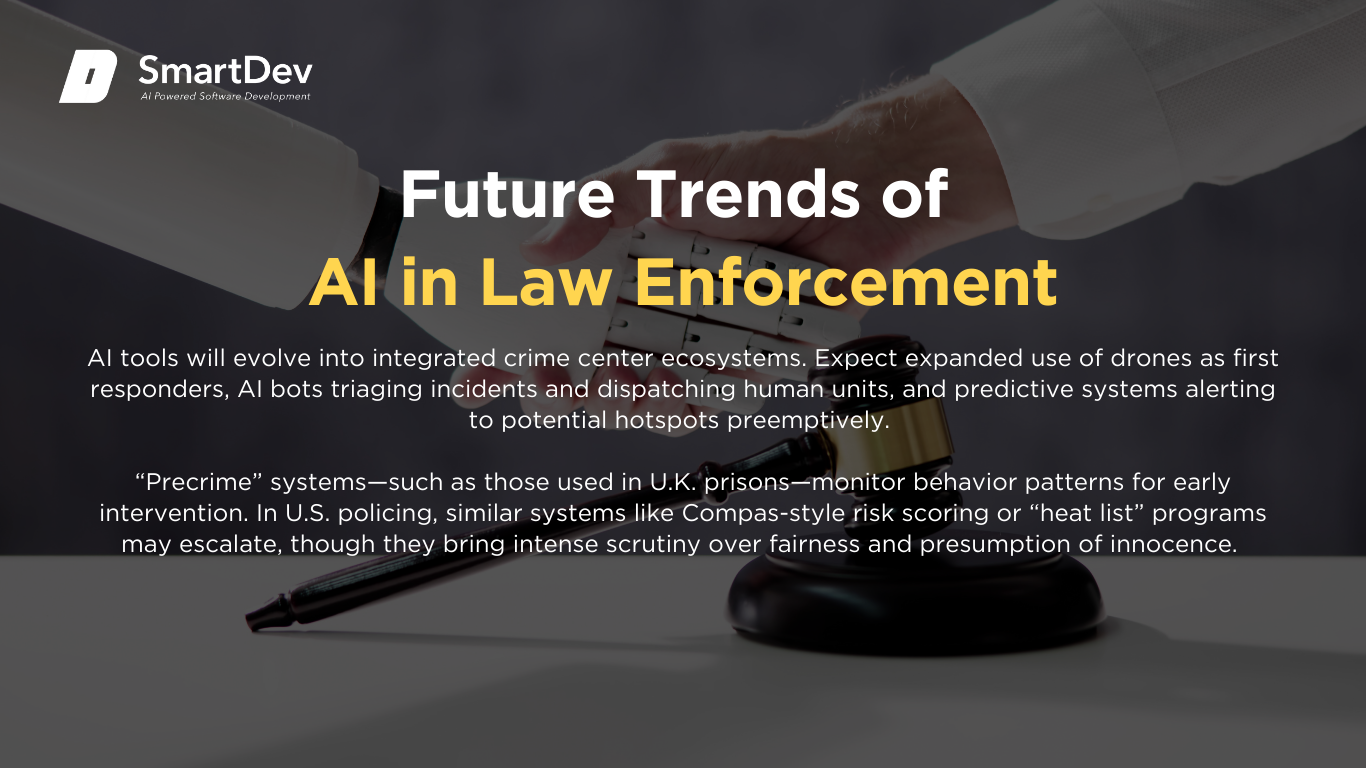 Predictions for the Next Decade
Predictions for the Next Decade





